The Lanzarote Atlantic Ocean is a breathtaking underwater environment teeming with incredible marine life, making it an attraction for both nature lovers and marine lovers.
Located within the Canary Islands, this expansive ocean is home to an incredible variety of species, from vibrant fish and majestic rays to enigmatic creatures hidden beneath the waves.
Known for its crystal-clear waters and thriving biodiversity, the Lanzarote Atlantic Ocean invites divers and researchers to explore its depths, uncovering the mysteries of its ecosystem.
With its unique volcanic landscapes and rich marine habitats, it stands as a vital natural treasure, highlighting the importance of ocean conservation and sustainable tourism.
Angel shark
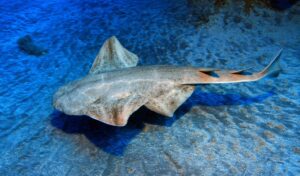
The angel shark is one of the most fascinating marine species found in the waters around Lanzarote. Recognizable by its flattened body and broad pectoral fins, it resembles a stingray, although it is a shark species.
Once widely distributed across European waters, the angel shark is now critically endangered, making the waters around Lanzarote a crucial habitat for its survival.
This unique predator is an ambush hunter, often burying itself in the sand to blend into the seabed and waiting patiently to strike unsuspecting prey such as fish and crustaceans.
Conservation efforts in Lanzarote are key to protecting the angel shark’s population and ensuring the survival of this extraordinary species for future generations.
Parrot fish
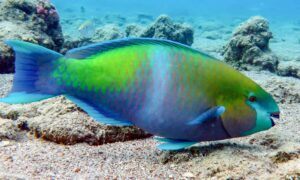
Parrot fish are vibrant and colorful inhabitants of Lanzarote’s waters, playing a vital role in maintaining the health of coral reef ecosystems.
These fascinating fish are known for their distinct beak-like teeth, which they use to scrape algae from rocks and dead coral, preventing overgrowth that can harm the underwater environment.
Remarkably, parrot fish also contribute to the formation of sandy beaches, as the coral they consume is excreted as fine sand. Their presence is an essential component of marine biodiversity, and ensuring their protection helps support the resilience of marine habitats in Lanzarote’s delicate ecosystem.
Barracuda
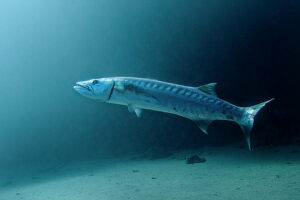
Barracudas are sleek, predatory fish known for their streamlined bodies and sharp, fang-like teeth.
These fascinating creatures are often spotted in the waters around Lanzarote, gliding effortlessly through the currents with their powerful tails.Barracudas feed mainly on smaller fish, using their speed and agility to ambush their prey.
They play a crucial role in maintaining the balance of the aquatic food chain, ensuring a healthy ecosystem.
With their silvery, reflective scales and intimidating presence, barracudas are a captivating sight for divers and snorkelers exploring Lanzarote’s vibrant underwater world.
Atlantic Stingray
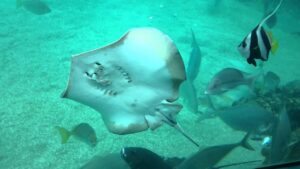
The coastal waters surrounding Lanzarote provide a sanctuary for the Atlantic Stingray (Hypanus sabinus), a captivating marine species that adds to the island’s underwater charm. These graceful rays navigate the sandy seabeds and vibrant sea grass fields with ease, flourishing in the warm Atlantic currents that envelop this stunning Canary Island.
Distinguished by its diamond-shaped disc that can span up to 24 inches and its signature venomous barb, this remarkable creature spends most of its time partially buried in sand, creating small depressions as it hunts for mollusks, worms, and small crustaceans.
What makes the Atlantic Stingray particularly unique is its incredible electroreception ability—specialized cells called ampullae of Lorenzini detect the electrical fields generated by prey hiding beneath the sediment, making it an incredibly efficient predator.
Octopus in Lanzarote
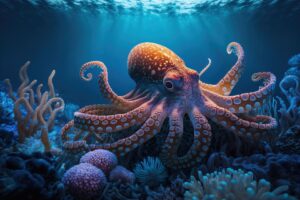
The octopus, one of the ocean’s most intelligent invertebrates, thrives in Lanzarote’s rocky volcanic reefs and underwater caves, where its remarkable problem-solving abilities and shape-shifting talents make it a master of survival.
Octopuses have three hearts and blue, copper-based blood—perfect adaptations for surviving the changing oxygen levels in the Atlantic waters around the Canary Islands’ one-of-a-kind underwater environment.
What truly sets octopuses apart is their incredible camouflage system—over 10,000 chromatophores in their skin can change colour and texture in milliseconds, allowing them to mimic everything from coral formations to rocky surfaces found along Lanzarote’s dramatic coastline.
Moray Eel
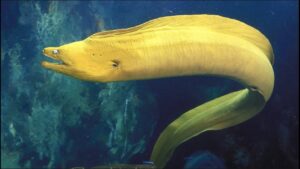
The Moray Eel is one of Lanzarote’s most impressive marine predators. These snake-like fish live in rocky crevices and volcanic caverns along the island’s Atlantic shore. Moray eels can grow up to six feet in length.
Their strong jaws include razor-sharp teeth made to grab prey. Unlike other fish, morays have a second set of jaws in their throat called pharyngeal jaws.
These jaws pull captured prey deeper into their gullet. Around Lanzarote, the Green Moray (Gymnothorax funebris) is commonly spotted by divers.
These eels are actually brown, but their yellow mucus coating creates a greenish appearance. Morays are ambush hunters.
They remain hidden in rock formations during the day and hunt at night. Their excellent sense of smell helps them locate fish, octopus, and crustaceans in dark waters.
Sea horse
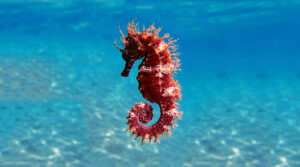
The seahorse is one of the ocean’s most unique fish species found in Lanzarote’s protected seagrass beds. These tiny creatures measure just 2-8 inches long.
Seahorses are fascinating creatures with a head shaped like a horse and a curled, grasping tail. What’s even cooler? Their eyes work independently, so they can keep an eye out for predators and prey at the same time!
Around Lanzarote’s coastline, the Long-snouted Seahorse (Hippocampus guttulatus) thrives in shallow waters among algae and sea grass.
Seahorses aren’t the best swimmers because of their upright stance. To stay steady while feeding, they wrap their tails around plants for support. Their menu? Mostly tiny crustaceans and plankton!
What makes seahorses truly remarkable is their reproductive process. In an amazing twist of nature, it’s the male seahorses that carry and give birth to the babies! Their brood pouch acts like a cozy incubator, holding up to 200 eggs for several weeks. Seahorses mate for life and perform elaborate courtship dances.
In Lanzarote’s marine reserves, these delicate creatures face threats from habitat loss and collection for traditional medicine. Conservation efforts help protect their seagrass nurseries around the Canary Islands.
Trigger fish
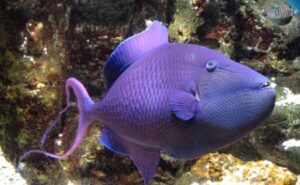
Triggerfish are vibrant and feisty creatures often spotted near Lanzarote’s rocky reefs and volcanic landscapes. Built tough, these bold fish can reach up to 12 inches in length!
Their name comes from a unique dorsal fin mechanism. The first spine locks upright like a trigger when the fish feels threatened.
This defensive feature helps them wedge into coral crevices where predators cannot reach them.
Around Lanzarote’s waters, the Grey Triggerfish (Balistes capriscus) is frequently spotted by snorkelers and divers. Triggerfish come equipped with powerful jaws and sturdy teeth, perfect for crunching through shells and coral with ease!
They feed on sea urchins, crustaceans, and mollusks found along the island’s underwater cliffs. These territorial fish are known for their bold behaviour during breeding season.
Males create and fiercely guard circular nests in sandy areas between rocks.Triggerfish are fiercely territorial and won’t hesitate to chase off intruders—even divers who get a little too close!
Despite their small size, triggerfish can deliver painful bites with their sharp teeth. Local dive operators advise maintaining distance when observing these feisty fish in Lanzarote’s Atlantic waters.
With their striking colors and playful curiosity, triggerfish are a favorite focus for underwater photographers!
Cuttlefish
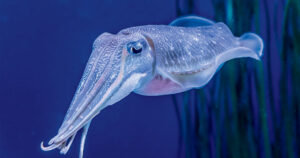
The cuttlefish is a remarkable marine cephalopod that thrives in Lanzarote’s coastal waters and rocky Atlantic reefs. These intelligent creatures measure between 6-10 inches long and belong to the same family as octopuses and squid.
Cuttlefish have a special internal shell, known as a cuttlebone, that helps them stay perfectly buoyant, letting them hover effortlessly in the water.
In Lanzarote’s volcanic underwater world, the Common Cuttlefish (Sepia officinalis) shows off its amazing camouflage skills, thanks to millions of color-shifting cells in its skin called chromatophores.
These cells create instant patterns and colors to match their surroundings perfectly. Cuttlefish are ambush predators that hunt small fish, crabs, and shrimp.
With two long feeding tentacles, cuttlefish can strike their prey in the blink of an eye—lightning fast and incredibly precise!. During mating season, males perform elaborate courtship displays with rapidly changing skin patterns.
Dusky Grouper
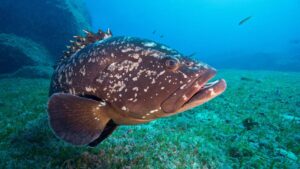
The Dusky Grouper stands out as one of Lanzarote’s biggest and most impressive predators!. These impressive giants can grow over five feet long and weigh up to 130 pounds.
They inhabit deep rocky reefs and underwater caves along the island’s volcanic Atlantic coastline. Dusky Groupers (Epinephelus marginatus) are ambush hunters with massive mouths.
They swallow prey whole, including octopus, fish, and crustaceans. These solitary fish are extremely long-lived, reaching ages of 50+ years.
Young groupers start life as females and transform into males as they mature. Around Lanzarote’s protected marine reserves, these gentle giants face divers with curious but cautious behavior.
Their mottled brown coloration provides perfect camouflage against volcanic rock formations. Conservation efforts have helped recover local populations after decades of overfishing threatened their survival in Canary Islands waters.
Conclusion | Lanzarote Atlantic Ocean
The Lanzarote Atlantic Ocean is teeming with amazing marine life—a vibrant biodiversity that truly deserves our care and respect.These ten remarkable creatures represent just a fraction of the species thriving in the Canary Islands’ unique volcanic ecosystem.
From the intelligent octopus to the majestic dusky grouper, each animal plays a vital role in maintaining healthy ocean balance. Climate change and human activities continue to threaten these fragile marine habitats.
Responsible diving practices and marine conservation efforts are essential for preserving Lanzarote’s underwater treasures. By supporting local marine reserves and sustainable tourism, we can ensure future generations will experience the wonder of swimming alongside these amazing Atlantic Ocean inhabitants.
Every dive reveals nature’s incredible adaptability and beauty.
Frequently Asked Questions
What makes Lanzarote’s Atlantic Ocean special?
Lanzarote’s Atlantic waters offer unique volcanic landscapes both above and below the surface. The island’s position in the Canary Islands creates ideal conditions for marine life, with year-round warm temperatures and exceptional underwater visibility.
What is the best time to visit Lanzarote’s Atlantic coast?
Lanzarote enjoys a subtropical climate with pleasant ocean conditions year-round. The warmest water temperatures occur from July to October (72-75°F), while the cooler months from December to March still maintain comfortable temperatures around 64-68°F.
Are the Atlantic waters around Lanzarote safe for swimming?
Yes, the waters are generally safe for swimming. However, always check local conditions and follow posted safety guidelines. Some areas may have stronger currents or waves, so it’s recommended to swim at designated beach areas with lifeguard supervision when possible.
What ocean is Lanzarote in?
Lanzarote is located in the Atlantic Ocean, specifically in the eastern part of the Atlantic off the coast of Northwest Africa. The island is part of the Canary Islands archipelago and is surrounded by the crystal-clear waters of the Atlantic.
Why is Lanzarote so famous?
Lanzarote is renowned for its unique volcanic landscapes, pristine beaches, and year-round pleasant climate. The island is famous for its dramatic black sand beaches, the stunning Timanfaya National Park with its active volcanic activity, and the architectural influence of César Manrique. It’s also a UNESCO Biosphere Reserve, making it a popular destination for eco-tourism and sustainable travel.
Is Lanzarote closer to Africa or Spain?
Geographically, Lanzarote is much closer to Africa than mainland Spain. The island sits approximately 70 miles (125 km) off the coast of Morocco, while it’s about 600 miles (1,000 km) from the Spanish mainland. However, politically and culturally, Lanzarote is part of Spain and the European Union as one of the Canary Islands.